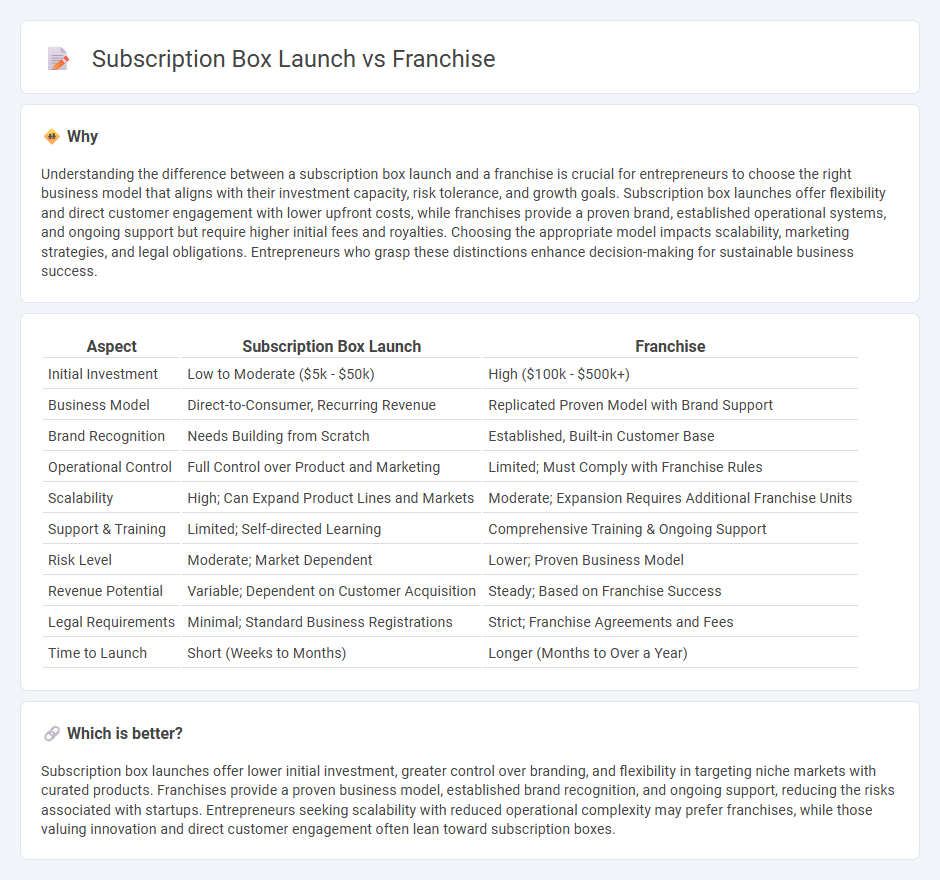
Launching a subscription box offers entrepreneurs scalable control over branding, customer experience, and product curation with relatively low initial investment compared to franchise ownership. Franchises provide access to established brand recognition, proven business models, and ongoing support but require adherence to strict operational guidelines and higher upfront fees. Explore detailed comparisons to determine which entrepreneurial path aligns best with your business goals and resources.
Why it is important
Understanding the difference between a subscription box launch and a franchise is crucial for entrepreneurs to choose the right business model that aligns with their investment capacity, risk tolerance, and growth goals. Subscription box launches offer flexibility and direct customer engagement with lower upfront costs, while franchises provide a proven brand, established operational systems, and ongoing support but require higher initial fees and royalties. Choosing the appropriate model impacts scalability, marketing strategies, and legal obligations. Entrepreneurs who grasp these distinctions enhance decision-making for sustainable business success.
Comparison Table
| Aspect | Subscription Box Launch | Franchise |
|---|---|---|
| Initial Investment | Low to Moderate ($5k - $50k) | High ($100k - $500k+) |
| Business Model | Direct-to-Consumer, Recurring Revenue | Replicated Proven Model with Brand Support |
| Brand Recognition | Needs Building from Scratch | Established, Built-in Customer Base |
| Operational Control | Full Control over Product and Marketing | Limited; Must Comply with Franchise Rules |
| Scalability | High; Can Expand Product Lines and Markets | Moderate; Expansion Requires Additional Franchise Units |
| Support & Training | Limited; Self-directed Learning | Comprehensive Training & Ongoing Support |
| Risk Level | Moderate; Market Dependent | Lower; Proven Business Model |
| Revenue Potential | Variable; Dependent on Customer Acquisition | Steady; Based on Franchise Success |
| Legal Requirements | Minimal; Standard Business Registrations | Strict; Franchise Agreements and Fees |
| Time to Launch | Short (Weeks to Months) | Longer (Months to Over a Year) |
Which is better?
Subscription box launches offer lower initial investment, greater control over branding, and flexibility in targeting niche markets with curated products. Franchises provide a proven business model, established brand recognition, and ongoing support, reducing the risks associated with startups. Entrepreneurs seeking scalability with reduced operational complexity may prefer franchises, while those valuing innovation and direct customer engagement often lean toward subscription boxes.
Connection
Subscription box launches and franchises share a scalable business model focused on recurring revenue and brand consistency. Entrepreneurs utilize subscription boxes to test market demand and establish customer loyalty before expanding through franchising. Franchises replicate the successful subscription box model across multiple locations, maximizing reach and profitability.
Key Terms
Business Model
Franchise business models involve replicating an established brand with standardized operations, offering franchisees a proven path to market entry and potential scalability. Subscription box launches center on curating personalized product assortments delivered periodically, relying heavily on customer acquisition and retention through unique experiences and recurring revenue. Explore the nuances of each model to determine the optimal strategy for your entrepreneurial goals.
Revenue Stream
Franchise models generate revenue primarily through initial franchise fees and ongoing royalties based on sales performance, offering scalable income tied to physical or service locations. Subscription box launches rely on recurring monthly subscription fees, creating a predictable revenue stream driven by customer retention and lifetime value. Explore deeper insights into optimizing revenue streams for both franchise and subscription box business models.
Customer Acquisition
Franchise models leverage established brand recognition and proven operational systems to acquire customers rapidly and maintain loyalty, often requiring higher upfront investment. Subscription box launches depend heavily on targeted digital marketing strategies and personalized offers to attract and retain users in a competitive market with lower initial costs. Explore detailed customer acquisition tactics to determine the best fit for your business growth strategy.
Source and External Links
A Consumer's Guide to Buying a Franchise - A franchise allows an investor (franchisee) to operate a business using the franchisor's brand and system, paying initial fees, royalties, and sometimes advertising fees, while receiving training and support from the franchisor.
Franchising - Wikipedia - Franchising is a strategy for business expansion where a franchisor licenses its business model and brand to a franchisee, who pays fees and must comply with set obligations, providing a way to grow with minimized capital risk.
What is a Franchise - International Franchise Association - A franchise is a licensing relationship for business expansion, where the franchisor provides the brand, product, and operational support to franchisees who conduct business under the franchisor's trade name and standards.
 dowidth.com
dowidth.com